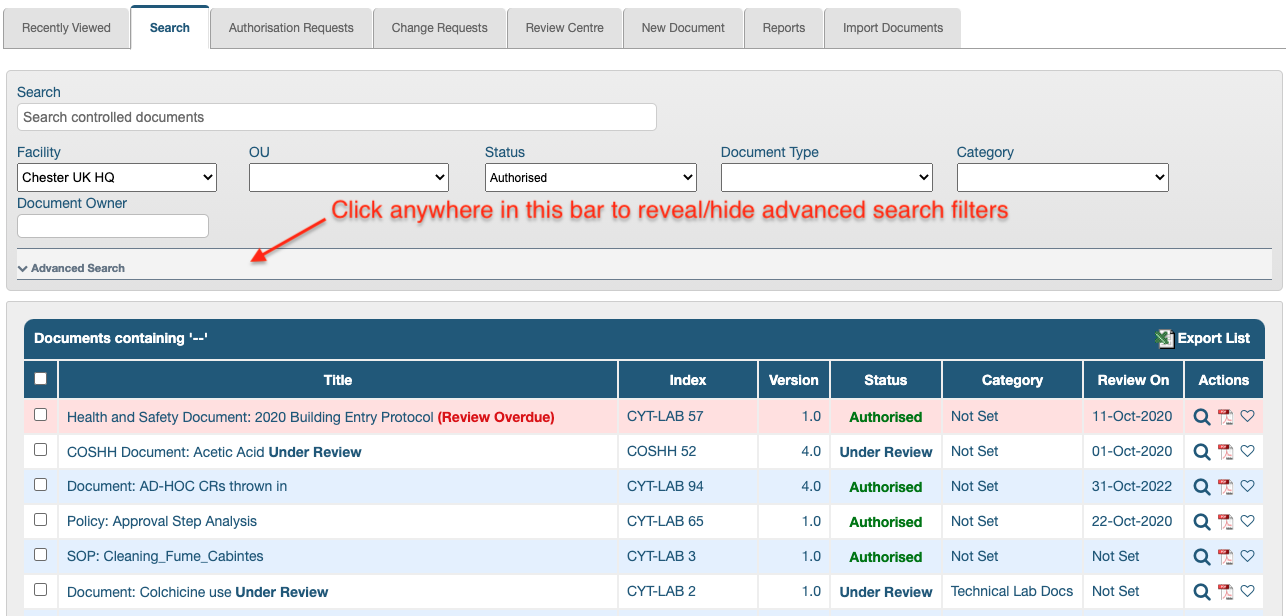- Document Searching
Document Searching
Introduction
The document search screen can be used to search for specific documents, to export a report of selected documents and also to update ownership and sharing options across multiple documents at once.
The Search tab opens by default when navigating to Laboratory Records > Controlled Documents.
Permissions
Controlled document permissions are particularly granular, allowing users to Edit SOPs yet only view Policies, for example. Every type of document (Policies, SOPs, etc.) has its own set of permissions(e.g., “Policies:View Authorised Policies”, “SOPs:View Authorised SOPs”).
The two basic forms of permissions required are: "< doc.type > :View Authorised < doc.type >" and "< doc.type > :Search < doc.type >" (e.g., “SOPs:View Authorised SOPs”, “SOPs:Search SOPs”). The ‘search’ permission gives access to the Search facility; the ‘view’ permission allows opening controlled documents once they are found through a search.
Additionally, there are permissions to view Draft documents (e.g., “SOPs:View Draft SOPs”), permissions to view Superseded documents (e.g., “SOPs:View Superseded SOPs”) and permissions to view documents Under Review (e.g., “SOPs:View Under Review SOPs”).
Finally, when a controlled document expires or is made inactive, the permission, “Records:View Inactive Records” is required to view it.
All the permissions above except, “Records:View Inactive Records”, only apply in the Organisational Units (OUs) where the user has been granted any of these permissions.
Document Search Filters
The main search filters under the tab, Search, are always visible. To save screen space, an additional set of search filters are normally hidden from view and they can be accessed by clicking the Advanced Search bar.
As search criteria is entered, the results are updated automatically in the table below the search area.

The main filters are:
- Search - free text can be entered; the system will search indexes, titles and within the ‘Subject’ and ‘Introduction and Scope’ fields of controlled documents
- OU - every controlled document lives in an OU; users can only see and select OUs where they have permissions to access controlled documents
- Status - the following choices are available:
- ‘Blank’ - selects all statuses
- Authorised - includes ‘Under Review’ and ‘Pending Release’
- Pending Release
- Draft
- Pending Authorisation
- Superseded
- Under Review
- Document Type - there are 7 set types of documents in iPassport (leaving the field ‘Blank’ selects all types):
- COSHH Document
- Document
- External Document
- Health and Safety Document
- Job Description
- Policy
- SOP
- Category - categories are user created options and they are shared by all OUs so all categories should be visible under this filter
- Document Owner - a search-as-you-type filter matches text entered to names of existing document owners; the desired name must be selected from the dropdown list which appears under the field
The Advanced Search filters are:
-
Date - is after - is before -
The ‘date’ filter offers the options--
Created
-
Review Due
-
Superseded
-
Last Reviewed
-
Expiry Date
-
Inactivated
The other two fields (is after and is before) have pop-up calendars to define the start and end dates of the search scope
Expired documents are effectively ‘inactive’. Any documents that have already expired or which have been inactivated, will only come up in results if the State filter is set to, Inactive.
-
-
Document Reviewer - a search-as-you-type filter matches text entered to names of existing document reviewers; the desired name must be selected from the dropdown list which appears under the field
-
Receive Notifications - a search-as-you-type filter matches text entered to names of existing users on review Notification Lists; the desired name must be selected from the dropdown list which appears under the field
-
Author - a search-as-you-type filter matches text entered to names of existing document authors; the desired name must be selected from the dropdown list which appears under the field
-
Section - a search-as-you-type filter matches text entered to ‘Locations’ which have been used as ‘Sections’ in existing documents; the desired section must be selected from the dropdown list which appears under the field
-
State - only allows choosing between Active or Inactive ; it always defaults to Active, keeping retired documents out of the lists unless required
-
Order By - offers a set of options to sort the search results by,
- Title (A-Z)
- Title (Z-A)
- Index (A-Z)
- Index (Z-A)
- Version (Lowest First)
- Version (Highest First)
- Status (A-Z)
- Status (Z-A)
- Type (A-Z)
- Type (Z-A)
- Created At (Ascending)
- Created At (Descending)
- Expiry (Ascending)
- Expiry (Descending)

FINDING INACTIVE DOCUMENTS
Retired / ‘inactive’ documents are hidden by default. They are easily revealed if the State filter is set to, Inactive.
Exporting Search Results
The results from a search performed with any of the criteria above can be exported as a spreadsheet in CSV format by clicking, Export List (found in the top right corner of the results table). In addition to the columns displayed on screen, these reports include all the metadata of the documents and information about their reviews.